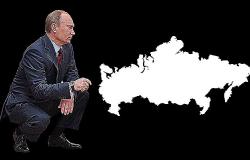Oligarchs and Oligarchs

Branko Milanovic uses Olsen's roving and stationary bandits framework to explain Russia's contemporary oligarchs.
Vladimir Putin’s recent interview to the Financial Times has, understandably, attracted lots of attention. (The full text is here). It seemed that everybody felt the need to respond. At times, these responses were odd, as was Donald Tusk’s rebuttal of Putin’s claim that “liberalism is obsolete”. Does the head of the European Council need to respond to every president’s interview even to the parts where the European Union is not mentioned? Many other commentators have focused on Putin’s intentionally insulting comments regarding migrants, “end of multiculturalism” statement, and still on another “end” adduced by Putin, that of Russian oligarchs.
It is with the latter one that I would like to deal. Asked if there are oligarchs in Russia Putin baldly claimed that there were none: “We do not have oligarchs anymore. Oligarchs are those who use their proximity to the authorities to receive super profits. We have large companies, private ones, or with government participation. But I do not know of any large companies that get preferential treatment from being close to the authorities”.
This is of course in manifest contradiction with the facts. The names of the richest Russians are not a secret, and almost all of them are in one or another way linked with the state and often with Putin personally. Caroline Freund in her book “Rich people, poor countries” shows that in 2014, 63% of Russian billionaires’ wealth comes from dubious privatization schemes, mineral resource wealth (which is almost always connected with state-given privileges) and outright political connections. For comparison, the equivalent figure in Latin America is 8.8% and in OECD countries 4.2%.
Thus, factually, Putin’s statement is wrong. Yet, in a different sense, it contains some truth—the truth hidden in the use of the same term “oligarch” for two different types of powerful rich people. This duality between oligarchs and oligarchs was well noticed by Henry Foy in today’s Financial Times, but he fails, in my opinion, to draw the implication of the distinction to its logical conclusion.
The Putin oligarchs are billionaires which “serve” at the discretion of the state. As a Russian commentator once said, they should all consider themselves to be temporary custodians of their wealth. If they fall from grace with the regime they could be stripped of their assets either through dubious legal proceedings, or if needed, more forcefully by being imprisoned.
The original kind of Yeltsin-type oligarchs, which “popularized” the term, were different. These oligarchs owned the state—so the state existed only at their discretion. At the peak of their power, after Yeltsin’s reelection in 1996 which they helped him win (in the deal that led to the infamous “loans for shares” trade) oligarchs, separately, controlled Yeltsin and practically most of the levers of state power. Since they also jockeyed for power amongst themselves with some being allied with the military, others controlling natural monopolies, and the third group having their own media, Russia at the end of the 1990s was a country on the verge of a civil war. It stood not so far from where Libya stands today. Under that “regime”, life expectancy fell from 69 to 64.5 years, the largest decline in life expectancy ever recorded in peacetime. It was today’s US opiate crisis multiplied by ten or more.
Russia was a county ruled, to borrow Mancur Olson’s terminology, by roving bandits. What Putin accomplished through reining in of the roving bandit oligarchs was to create a system of stationary bandits whose wealth depends on proximity to the state and who, like every stationary bandit, have more of an interest in the strength of the state and the welfare of its population—simply because such welfare is more closely intertwined with theirs.
It is in that sense that Putin’s oligarchs represent an improvement. Since foreign commentators do not have to live in countries on whose democratic records they expatiate, they are often wont to confound the two types of oligarchs. But for people who have to live under the two alternative regimes (roving or stationary bandits) the choice is rather simple.
It is a choice of living in a state of incipient civil war where you do not know what might happen to your children in school, where you could be randomly beaten up in the street, abducted by different private militias, or evicted from your home by one mafia today and another tomorrow. Indeed, the same things can happen under the centralized kleptocratic regime (such as Putin’s), but there these things happen with certain “logic” and “order”. Differently put, punishment is exacted for political disobedience and the rules of conduct are well known. In the system of disorderly roving bandits, punishment can be meted out randomly, or can be done for entirely different actions or reasons—some of which may displease one baron/bandit but not another. Under that chaotic system, violence can come from any direction, for any reason, and at any time.
To the outside observers, the system of random violence—because foreign observers are exempt from it, as indeed foreigners were exempt during Russia’s “decade of humiliation”—might seem more democratic. There are indeed alternative centers of power in competition with each other, there is freedom of speech, each media empire owned by one baron attacks the media empire owned by another baron, and there thus appears to be a political life despite absence of a rule of law, rampant corruption, and physical insecurity. The system of stationary bandits is monochromatic by comparison but for people who live under it more predictable and much safer.
The truth is that large part of the world’s population has only a choice between these two systems: between multi-original kleptocracy and anarchy, and more centrally controlled enrichment. There is no surprise that most ordinary people will select stability over chaos, predictable violence over random violence, and some administration of justice over none.
This post first appeared on Branko's blog and was reposted with permission.
Image credit: Democracy Chronicles via Flickr Public Domain Mark 1.0


